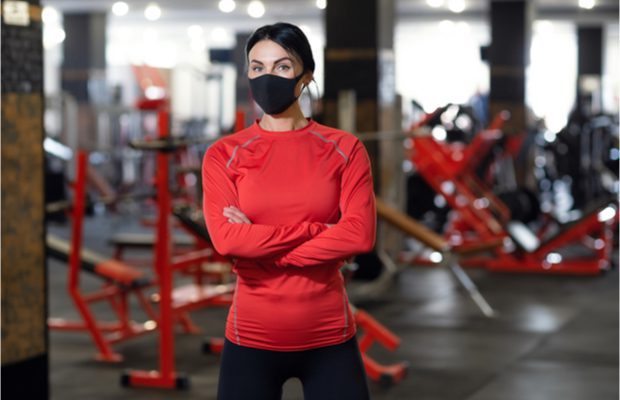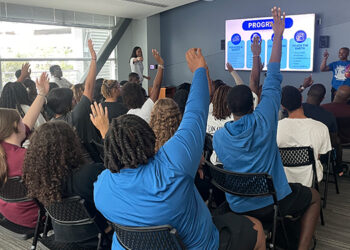
If you need a conversation starter with colleagues in this industry, reopening rec centers is the topic to chat about right now.
Campuses across the nation are deep in discussion on it. Aaron Mowen, the director of Campus Recreation at Saginaw Valley State University, said while no decisions have been made at his school, they have discussed a number of areas on reopening that include hours of operation, limiting access, equipment spacing, repurposing of basketball courts, closing off certain areas like fitness studios for informal use, etc.
“I think a major concern will be how students and staff reintegrate into our spaces and programs, and feel confident they’re safe,” said Mowen.
Over at the University of Maryland, Baltimore County (UMBC), the campus is following guidelines set forth by the state’s governor. “Our campus leadership at UMBC continues to provide us with guiding principles to work through COVID-19,” said Gary Wohlstetter, the senior associate athletic director. “Internally within our staff we are having conversations. Our goal is to provide our users with a safe and secure facility while being cognizant of the overall well-being of our participants with a focus on mental health.”
Conversations at UMBC on reopening rec centers have included the following:
- Finding a balance between contact and interaction for professional and student staff, both with one another and participants.
- Identifying all high-level touch points and how to provide safe access to the facility.
- Social distancing with a focus on high traffic areas.
- The distance between equipment and the number of users in the facility.
- Restroom access and an increase in hand sanitizer locations.
At Colorado State University Pueblo, there are several things the campus recreation team has been working on. Emily McElwain, the director of Student Recreation, shared the list:
- Signage at entrances regarding hygiene, feeling ill, spacing/distancing expectations and limits to the number of people in spaces. “We are considering only allowing one person per 100 square feet, so for us that is approximately 40 to 60 people at a time, depending on if our pool is open,” said McElwain.
- Hours will be reduced due to the usual summer schedule. The back gate that connects to an academic building will be closed unless there are pool programs. This is to limit access points, better monitor members and limit the number of staff on shift.
- Each area in the facility will also have specific signage reminding members to clean equipment, keep six feet apart, etc.
- All equipment will be removed and replaced to have a six-foot perimeter around each piece.
- In the free weight and functional training areas, six-foot boxes will be marked for members to use.
- Staff will be required to wear a mask at all times unless they are outside or are alone with spacing of 10 feet or greater – such as in laundry rooms, offices or unoccupied spaces. “We are working with a local group to have university branded masks for each staff member that will be assigned to them and laundered after each shift,” said McElwain. “We will keep these onsite to ensure they are properly sanitized.”
- Members will be encouraged to wear masks but not required, which follows current state guidance. Staff will be required to wear gloves. Options for gloves, from disposable to reusable, are being researched.
- All medic kits will additionally be stocked with face shields and gowns, as recommendations for first responders recommend the additional PPE.
- Plastic glass shields will be installed at all points of service desks.
- There will be a new check-in process, in which options are currently being explored. “We are considering having members hold their IDs up for staff to review and just key in member numbers so we do not have to physically take the ID and swipe it,” shared McElwain on one of the options being explored.
- They will make sure the facility is well-equipped with soap, hand sanitizer, disinfectant spray bottles, single-use rags and disinfectant wipes. “Our custodial crew also have new cleaning protocols that will be completed twice daily,” said McElwain. “Once a month we will also work with an outside vendor for a product call EnviroShield, which is applied in a mist over all surfaces — walls, floors, equipment, etc.”
- One person staffed at a desk at a time. Any additional staff for busier times will be assigned to roam and clean.
- For all equipment rentals there will be curbside pick-up to limit the number of people in and out of the building.
- At this time, McElwain said they are anticipating in the first phase of reopening they will not allow group activities such as fitness classes or pick-up games on sport courts. “Colorado’s first phase of re-opening has been specific about no gatherings of 10 or more, so the group activity allowance could change later this summer,” she said.
- Even if the facility re-opens before July 1, it will not begin hosting events, camps or running team development programs until that time.
At UMBC, the biggest challenge for Wohlstetter and his team right now isn’t necessarily prep for reopening, but the fact they are in the middle of a Retrievers Activity Center Renewal Project. “Half of our facility is offline,” he said. “This creates greater challenges, which we will work through.”
But in the end, no matter what the obstacle, it comes down to communicating with the campus as a whole. So, whether you can make decisions today or only discuss possibilities when it comes to reopening rec centers, make sure you are relaying the information as best you can. “Be transparent while keeping everyone informed. Take action based on detailed planning and make decisions based on facts on the ground and the safety of students, faculty and staff,” said Wohlstetter.










